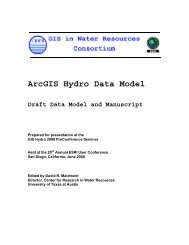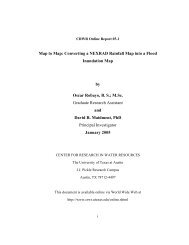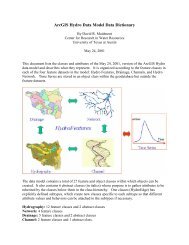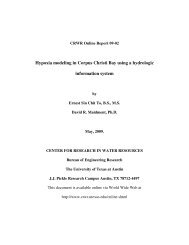View the Whole Report - Center for Research in Water Resources ...
View the Whole Report - Center for Research in Water Resources ...
View the Whole Report - Center for Research in Water Resources ...
You also want an ePaper? Increase the reach of your titles
YUMPU automatically turns print PDFs into web optimized ePapers that Google loves.
ema<strong>in</strong>ed <strong>in</strong> suspension and were able to pass through <strong>the</strong> silt fence because <strong>the</strong> diameters<br />
were smaller than <strong>the</strong> apparent open<strong>in</strong>g size (AOS) of <strong>the</strong> fabric.<br />
4.2.4 Turbidity Reduction Efficiency of Silt Fences<br />
The amount of turbidity reduction caused by silt fences was determ<strong>in</strong>ed by<br />
compar<strong>in</strong>g concentration <strong>in</strong> <strong>the</strong> pond created by <strong>the</strong> silt fence and concentrations <strong>in</strong><br />
samples collected below <strong>the</strong> silt fence. The calculated removal efficiency <strong>for</strong> silt fences<br />
is:<br />
Turbidity reduction % =<br />
Upstream Turbidity - Downstream Turbidity<br />
Upstream Turbidity<br />
x 100<br />
The median removal <strong>for</strong> all samples was only 2%, with a standard deviation of<br />
±10%. Removals range <strong>in</strong> magnitude from -32% to 49%. The computed values <strong>for</strong> all<br />
samples are presented <strong>in</strong> Table B4 <strong>in</strong> Appendix B. Increases <strong>in</strong> turbidity below <strong>the</strong><br />
temporary control fence probably are <strong>the</strong> result of <strong>the</strong> same sources of error that resulted<br />
<strong>in</strong> negative removals <strong>for</strong> TSS. S<strong>in</strong>ce turbidity is a function of <strong>the</strong> number of small<br />
particles <strong>in</strong> a sample, <strong>the</strong>se results are consistent with <strong>the</strong> f<strong>in</strong>d<strong>in</strong>g that all of <strong>the</strong> particles<br />
rema<strong>in</strong><strong>in</strong>g <strong>in</strong> suspension above <strong>the</strong> fence are smaller that <strong>the</strong> AOS of <strong>the</strong> fabric and<br />
consequently no reduction should be expected except <strong>for</strong> <strong>the</strong> particles which become<br />
attached to <strong>the</strong> fabric.<br />
4.2.5 Observations of Silt Fence Per<strong>for</strong>mance<br />
Comments of construction project supervisors <strong>in</strong>dicate that ma<strong>in</strong>tenance of<br />
temporary controls was not a consideration. Controls are removed or replaced frequently<br />
because of chang<strong>in</strong>g conditions on <strong>the</strong> construction site so that ma<strong>in</strong>tenance seldom is<br />
needed. However, various <strong>in</strong>stallation and ma<strong>in</strong>tenance deficiencies were noted dur<strong>in</strong>g<br />
<strong>the</strong> duration of <strong>the</strong> study.<br />
These silt fence <strong>in</strong>stallations are not designed as hydraulic structures to<br />
accommodate runoff from a ra<strong>in</strong>fall event of a particular frequency, and failures caused<br />
by volumes of runoff that exceed <strong>the</strong> capacity are common. A s<strong>in</strong>gle release around <strong>the</strong><br />
30



